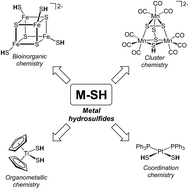Hydrosulfide complexes of the transition elements: diverse roles in bioinorganic, cluster, coordination, and organometallic chemistry
Abstract
Sulfur-based ligands are versatile donors that play important roles in a wide array of subdisciplines of inorganic chemistry including organometallic chemistry, bioinorganic chemistry, and cluster science. Despite the breadth of compounds containing sulfur-based ligands, those containing the simplest mercapto group, hydrosulfide ion (HS−), are significantly less developed. The acceptance of H2S/HS− as important biological signaling compounds during the last decade has engendered a renewed interest in the chemistry of these species. Bioinorganic reactivity of hydrosulfide, however, is only one aspect of its fascinating chemistry, much of which revolves around its interactions with transition metal ions. The coordination of HS− to d-block elements produces a unique class of substances that differ in significant ways from more ubiquitous metal thiolates. This review examines the preparation, structure, spectroscopy, and reactivity of such compounds and the roles they play across several fields of chemistry.



 Please wait while we load your content...
Please wait while we load your content...